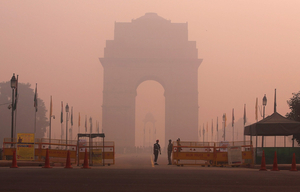Where are we headed this Diwali

I remember attending a workshop on water, in Gurgaon, where the mere collection of clouds in the sky scared the residents of water clogging. As we all know, rains in our country become an actual disaster. Akin to that the nearing of Diwali shivers the residents of Delhi, and the national capital region with the air they are going to breathe.
When only 10 days are left for the festival, the air pollution in the city has reached an alarming stage. It has crossed the national ambient standards of emissions; the WHO levels are way behind.
Moreover, the WHO has noted that one of the top 10 risk factors for human health happens to be the rising air pollution. The 17 Central Pollution Control Board (CPCB) and the four stations of System of Air Quality and Weather Forecasting and Research (SAFAR) have recorded Delhi’s air quality as poor, with a warning to the residents that the city has entered the red zone of air ambience.
The day-long peak of PM 2.5 and PM 10, which are ultrafine particulates, were 420 (whereas, the Indian standards should be 60), and 600 micrograms per cubic metre (whereas, the normal standard should be not more than 100). In addition, the air quality index of the Central Pollution Control Board (CPCB) was poor. To simplify this, it indicates that people are prone to having breathing problems. According to the SAFAR forecast, the air quality is going to become more vulnerable in days to come.
But have we not learnt any lessons from the past? If we look back to the 2015 infamous Republic Day celebrations in Delhi – this was even the topic of discussion between the then US President Barack Obama and Prime Minister Narendra Modi.
There was a discussion with an intent, but nothing really happened on the ground.
In fact, the situation has further worsened. Last year, the national capital earned the tag of the ‘smoke capital’.
The smart city paradigm of governance was supposed to address the air quality issues on priority basis. In fact, a cursory look at the smart city plans would exhibit a lot about that. However, a study revealed by ICLEI South Asia states that with the present set of directions for infrastructural development in the cities, the commitments made at COP21 by the government of India would remain completely elusive. It is not even 1 % of the budget that is being spent for meeting the climate change demands or reducing the carbon emissions. The only advancement that has been made is in the setting up of air monitoring centres in a few more cities which regularly monitor the air quality.
But again, is that enough? The present strategies are completely untenable to match this challenge.
Diwali, which is around the corner, is another serious challenge that will raise the air pollution levels which will further aggravate the problem. One of the studies done long ago post Diwali shows:
“A study was conducted in the residential areas of Delhi, India, to assess the variation in ambient air quality and ambient noise levels during pre-Diwali month (DM), Diwali day (DD) and post-Diwali month during the period 2006 to 2008. The use of fireworks during DD showed 1.3 to 4.0 times increase in concentration of respirable particulate matter (PM(10)) and 1.6 to 2.5 times increase in concentration of total suspended particulate matter (TSP) than the concentration during DM. There was a significant increase in sulfur dioxide (SO(2)) concentration but the concentration of nitrogen dioxide (NO(2)) did not show any considerable variation. Ambient noise level were 1.2 to 1.3 times higher than normal day. The study also showed a strong correlation between PM (10) and TSP (R (2) ≥ 0.9) and SO(2) and NO(2) (R (2) ≥ 0.9) on DD. The correlation between noise level and gaseous pollutant were moderate (R (2) ≥ 0.5). The average concentration of the pollutants during DD was found higher in 2007 which could be due to adverse meteorological conditions. The statistical interpretation of data indicated that the celebration of Diwali festival affects the ambient air and noise quality. The study would provide public awareness about the health risks associated with the celebrations of Diwali festival so as to take proper precautions.”
But shall we leave it there; and the answer has to be a big no. There is a Graded Responsibility Action Plan (GRAP) in Delhi, which focuses on more information in advance about the air quality, and then promotes programs to avoid, shift and term the conditions from moderate to poor and very poor, and then acts accordingly. But the practice proves that it is more on paper than real action.
For example, “who is going take charge of implementing these measures in a short turnaround time, with several agencies listed against each of the measures? Shutting down power plants and keeping an eye on landfills are easy – but how are we going to shut down 1,000 brick kilns within a 40-km radius of the city? What does it mean to intensify public transport when the Delhi’s minister of transport has declared there won’t be any new buses to support this action plan or during future odd-even instances? How do we keep vigil on more than six million cars and motorcycles in NCR, with a small fraction of traffic police on more than 25,000 km of roads?”
All these are challenges and questions that demand an affirmative action.
So let’s have a challenge to be accepted and negotiated. This Diwali let’s say no to crackers, no to smoke, and protect ourselves from the imminent disaster in the offing.
Tikender Panwar is the former Deputy Mayor of Shimla.


